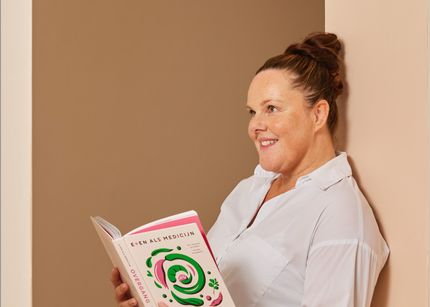Muscle stiffness and menopause
Muscle pain and stiffness during menopause can be caused by fluctuating hormone levels. The decrease in oestrogen is the main culprit. Stress can also affect your muscles. The fact that menopausal women are more susceptible to stress doesn’t help matters. Understanding what's happening in your body and taking good care of yourself can help ease these problems.

My body feels stiff and achy, despite the fact that I walk every day and take care of myself. - Wendy (age 57)

According to research, up to 70 percent of perimenopausal women report muscle pain and stiffness. Unfortunately, these symptoms may only get worse in postmenopause. Oestrogen levels remain low after menopause, which means the symptoms are not likely to disappear. However, this doesn’t mean you have to spend the rest of your life in pain. You can regain muscle strength and elasticity by taking good care of yourself and by training your muscles.
What is happening in your body?
Oestrogen stimulates the production of collagen, the most abundant protein in the body. Collagen constitutes 10 percent of muscle tissue. It helps keep your muscles strong and elastic and promotes muscle growth after physical exertion. By the way, collagen is not only an important building block for your muscles, but it also helps your cartilage, skin, ligaments and tendons to remain supple, strong and healthy.
When your oestrogen levels drop as a result of menopause, your collagen production decreases along with it. Over time you will notice that you feel stiff, your movements are less fluid, and it takes much more effort to get up in the morning.
Other causes
Stress can be a contributing factor as well. During menopause, shifting hormones make you more sensitive to stress. In addition, other factors, such as a demanding job, family life, an active social life and caring for elderly parents, can add to the stress that you may already be feeling. Too much stress can manifest itself physically.
Underlying health conditions, medication use or other hormone-related issues (such as hot flashes, heart palpitations or sleep problems) can also affect your mental and physical well-being.
Do you have bone or joint pain?
Declining levels of oestrogen and reduced production of collagen can also affect your joints. The cartilage can become thinner and mucous membranes start to lose moisture. As a result, bone will rub on bone, causing pain, irritation and inflammation. More about joint pain.
Low oestrogen and collagen also increases the risk of osteoporosis, a disease in which bones become weak and brittle, causing them to break or fracture more easily. About 20 percent of bone loss in women happens during menopause. Osteoporosis is called a ‘silent disease’ because there typically are no warning symptoms in the early stages of the disease. The good news is that by caring for your body the pitfall of osteoporosis can be avoided and bone loss can be slowed down. More about osteoporosis.
What can you do?
- The best defence against stress is relaxation. This also applies to your muscles. Are you getting enough sleep? Do you try to find moments to relax during the day? Your body needs this at this stage of life. Progressive muscle relaxation techniques can also help to release muscle tension and calm your nerves. Search YouTube for exercises you find enjoyable.
- Keep moving. Although you may not be able to move as smoothly as you used to, staying active will help you stay healthier and prevent aches and stiffness in the long term. Opt for low-impact sports such as yoga, walking or swimming, and try to find moments during the day to be active. Go for a walk with a friend instead of staying in and drinking coffee, walk an extra mile around the block, take the stairs instead of the elevator, walk or cycle to the supermarket, park your car a little further away. These small things can make a big difference.
- Avoid sugars and fast carbohydrates. Your muscles need energy to work. Sugar provides energy, but too much sugar isn’t good for muscle function. It raises blood sugar levels, reduces collagen production and hinders muscle growth.
- Eat more protein and healthy fats. This helps restore the leptin balance in your body. Leptin mediates the regulation of muscle mass. During menopause, the body becomes resistant to the effects of leptin. This can lead to inflammation and increase the risk of muscle and joint pain.
- Stimulate collagen production. Collagen helps keep joints and muscles strong and flexible. Vitamin C stimulates collagen production. Together, they improve muscle strength and flexibility. Some women benefit from collagen supplements, possibly with a Vitamin C supplement.
- Magnesium is good for muscle function. Magnesium is found in foods such as peanuts, spinach and bananas.

Medication for menopausal problems
Having a strong body is important, especially at this stage of life when your body demands a lot from you. In addition to a healthy lifestyle, you can manage menopausal symptoms with hormone therapy.

What treatments can help?
A healthy lifestyle is the basis for good health. Dietary supplements can be useful for filling in gaps in your diet. Depending on what symptoms you have and how intense they are, you may want to consider hormone replacement therapy (HRT).
Can hormone therapy help?
Hormone replacement therapy (HRT) can provide relief from symptoms such as hot flashes, sleep problems and mood swings. How? By replacing the hormones that are lost during menopause. HRT is used to treat women who suffer from muscle pain as well as other menopausal symptoms.
Sources
- Roman-Blas JA, Castañeda S, Largo R, Herrero-Beaumont G. (2009). Osteoarthritis associated with estrogen deficiency. PMID: 19804619.
- Lu CB, Liu PF, Zhou YS, Meng FC, Qiao TY, Yang XJ, Li XY, Xue Q, Xu H, Liu Y, Han Y, Zhang Y. (2020). Musculoskeletal Pain during the Menopausal Transition: A Systematic Review and Meta-Analysis. PMID: 33299396.
- Toussaint L, Nguyen QA, Roettger C, Dixon K, Offenbächer M, Kohls N, Hirsch J, Sirois F. (2021). Effectiveness of Progressive Muscle Relaxation, Deep Breathing, and Guided Imagery in Promoting Psychological and Physiological States of Relaxation. PMID: 34306146.
- MacDonald, T.L., Pattamaprapanont, P., Pathak, P. et al. (2020). Hyperglycaemia is associated with impaired muscle signalling and aerobic adaptation to exercise. https://www.nature.com/articles/s42255-020-0240-7
- Lis DM, Jordan M, Lipuma T, Smith T, Schaal K, Baar K. (2022). Collagen and Vitamin C Supplementation Increases Lower Limb Rate of Force Development. PMID: 34808597.
Your path to a smooth menopause starts here
Get the tools you need to navigate menopause with more ease and to educate yourself about your body. With tips and insights from experts, and relatable stories of women just like you. Press play, not pause.
Tips and advice


FAQ
Can the menopausal transition bring on osteoarthritis?
The role of sex hormones in the development of osteoarthritis has not yet been established beyond doubt. However, there does seem to be a connection between menopause and osteoarthritis. It has been shown that oestrogen is important for maintenance of the bones, joints and cartilage, and many women develop osteoarthritis or joint pain in their menopausal years. More about osteoarthritis.












